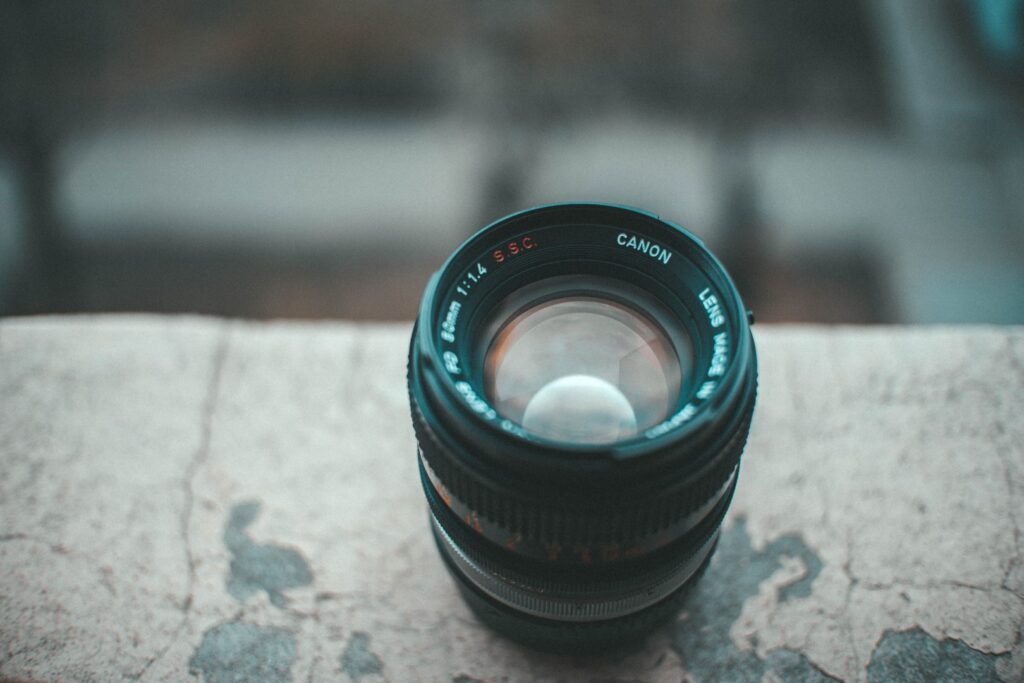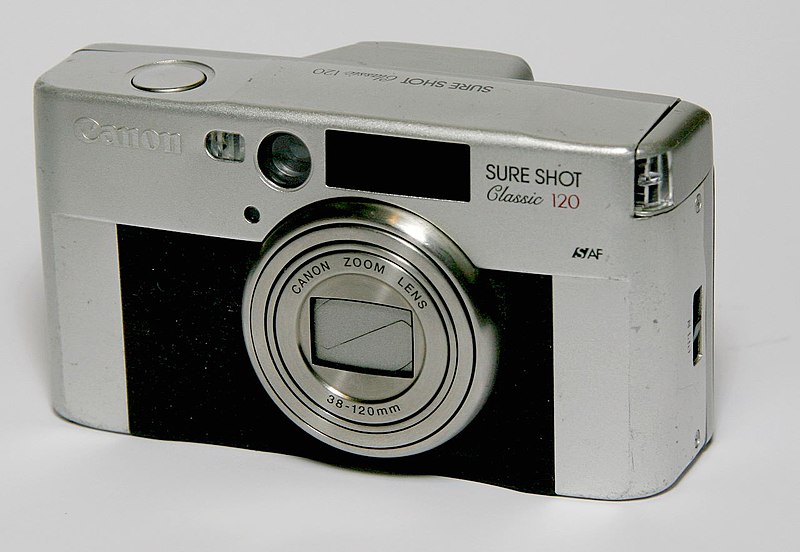In the world of film photography, the Canon AE1 and AE1 Program stand as iconic symbols. Introduced in the late 1970s and early 1980s, these cameras represent a transformative era in photography, offering advanced features and delivering excellent image quality that is still sought after by many photographers today. But let’s face it, even best of cameras are limited by the quality of lenses used. The right lens can capture your vision in the crispest of details, provide a unique perspective, or blur backgrounds to a creamy bokeh. That’s why we’re here to discuss lenses, specifically those perfectly compatible with the Canon AE1 and AE1 Program, to help you make the most out of these classic cameras.
In a Rush? Quick Lens Roundup:
- Canon FD 2.8/20 – For landscapes and architecture. (Price on eBay)
- Canon nFD 2.8/24 – Versatile wide-angle lens. (Price on Amazon)
- Canon nFD 1.4/50 – Excellent all-around lens. (Price on Amazon)
- Canon FD 1.8/85 – Superb for portraits. (Price on eBay)
- Canon nFD 2.8/135 – Ideal for portraits and landscapes. (Price on eBay)
For more in-depth analysis of each lens, keep reading!
Understanding the Breech Lock Mount FD Lenses: Variations and Implications
When delving into the world of Canon FD lenses, it’s important to understand their variations. Over the years, these lenses have gone through significant evolution, with each version bringing in its unique features, pros, and cons.
Variation 1 (1971-73): The first version of the FD lenses came with a silver breech-lock ring and a chrome nose, a combination that added a touch of vintage flair. There was no lens coating specification apparent, and the aperture ring had a green “o” at the end of the numerals indicating Auto Exposure. The charm of these lenses lies in their solid construction and the creamy bokeh they produce. However, their relatively slow speed compared to later versions and absence of multi-coating can be a downside for some.
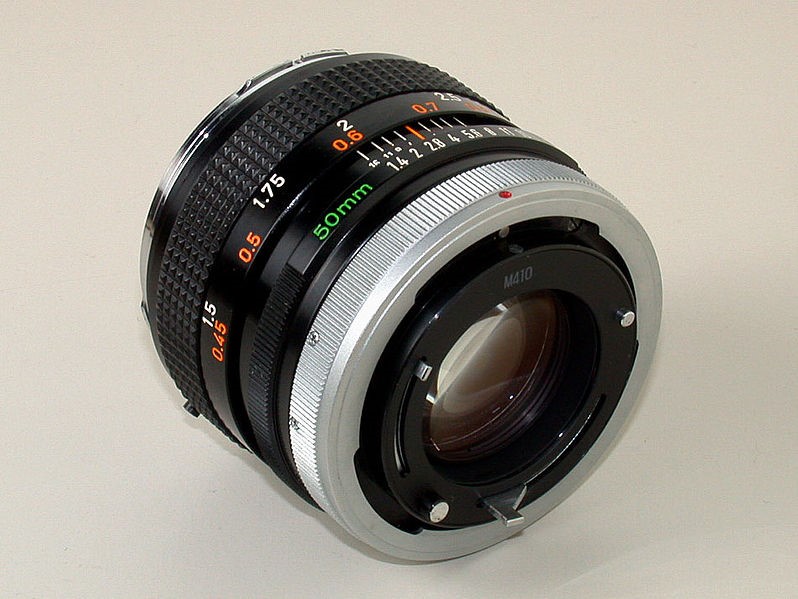
Variation 2 (1973-79): The second wave of FD lenses ditched the chrome nose but kept the silver breech-lock ring. Now, the lens coating type was clearly indicated on the ring around the front element, either being ‘S.C.’ in white or ‘S.S.C.’ in red. A green “A” at the end of aperture numerals indicated the lens set for AE operation, and a latch was added to hold the breech lock ring still until the lens was pressed into the lens mount. This variation marked a significant improvement over the first, with improved speed and superior Super Spectra Coating. However, the lenses were still fairly large and heavy, something that was addressed in the next variation.
FDn (1978): The third variation, also known as the ‘new FD’ or FDn, saw a significant redesign in the breech-lock mechanism. The ring was now black plastic with a square silver metal button to release the ring lock. This transition resulted in lenses that were generally lighter and more compact. The Super Spectra Coating became a standard across all lenses except the 50mm f/1.8, enhancing light transmission and reducing flares and ghosting. On the flip side, some photographers feel these lenses lack the solid feel of their predecessors, and the plastic components might not be as durable.
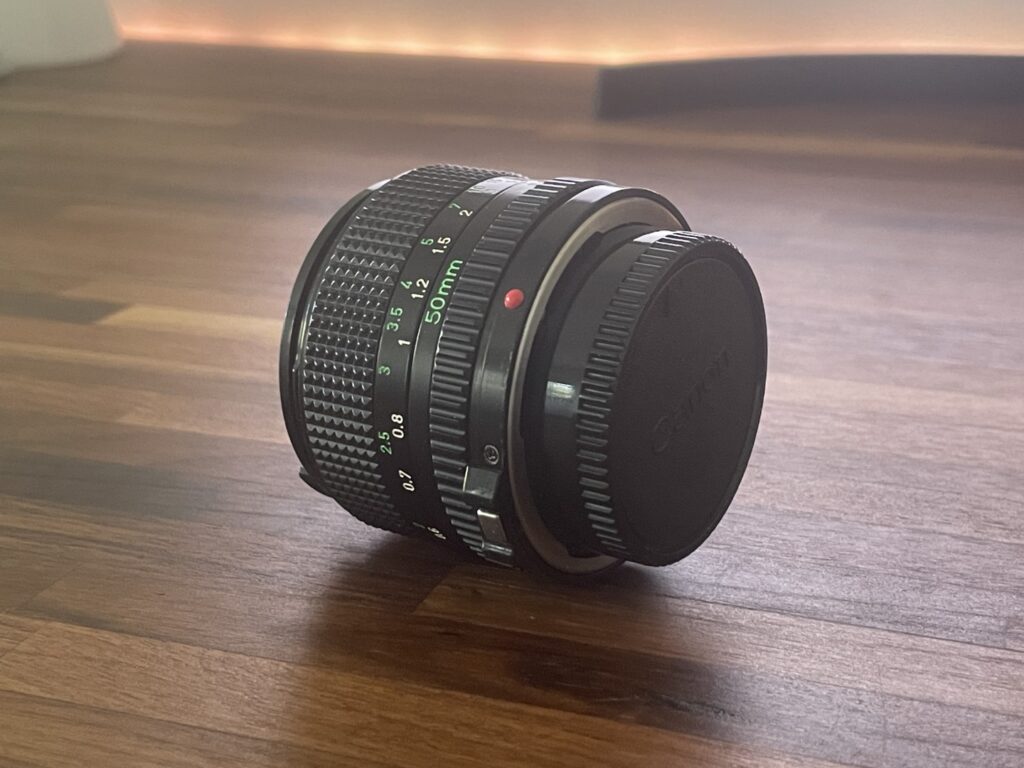
Beyond the Canon FD: Adapting FD Lenses to Other Mounts and Modern Cameras
The quality and character of FD lenses make them a worthy addition to any photographer’s kit, and their use is not restricted to FD-mount cameras. These lenses can be adapted to fit other camera mounts, including modern digital cameras. Adapters are widely available and can be a cost-effective way of expanding your lens arsenal while enjoying the unique aesthetic that FD lenses offer. However, it’s important to note that the use of adapters might mean giving up some functionalities like autofocus or electronic aperture control, which may not be an issue when using classic manual-focus FD lenses. It’s all about embracing the vintage charm!
Related content on the Canon AE-1/Canon AE-1P:
- The Ultimate Guide to Batteries for Your Canon AE-1 Program
- How to replace the light seals of the Canon AE-1 Program
- Is the Canon AE-1 a good Camera? And other common questions
- Reviewing the Canon AE-1 Program
Your Essential Lens Kit: Guiding You Through the Focal Lengths
Whether you’re a landscape enthusiast, a portrait pro, or an all-rounder who dabbles in every genre of photography, having a diverse range of focal lengths in your camera bag can significantly broaden your creative possibilities. A carefully chosen trio of prime lenses, spanning wide, standard, and telephoto focal lengths, can pretty much have you covered for the majority of your shooting scenarios. Let’s delve into why these ranges matter:
Wide Lenses (20-35mm): These lenses are your best bet for capturing vast landscapes, towering architectures, or interior spaces where you’re confined by the walls. With a wide field of view, these lenses let you capture more of the scene into your frame. On the Canon AE1 or AE1 Program, a lens in the 20mm to 35mm range can do wonders in bringing a unique perspective to your images, especially in landscape and architectural photography.
Mid-range Focal Length (50mm): Considered the ‘nifty fifty,’ a 50mm lens closely mimics the field of view of the human eye, making it an incredibly versatile lens. It’s perfect for capturing everything from portraits and street scenes to landscapes and close-up details with a natural perspective. If you could only have one lens, a 50mm would be a strong contender.
Telephoto Lenses (85-135mm): These lenses are particularly suited for portraits, allowing you to isolate your subject and create a pleasing, creamy background blur or ‘bokeh.’ The longer focal lengths also flatten the perspective, which can be flattering for portraiture. A lens in the 85mm to 135mm range will help you bring the focus on your subjects, whether it’s a stunning portrait or a distant subject in your landscape scene.
By having a wide, mid-range, and telephoto lens at your disposal, you’ll be prepared for a variety of shooting conditions. But which specific lenses should you consider for your Canon AE1 and AE1 Program? Let’s explore the top 5 recommendations in the next section.
Top 5 Lenses for the Canon AE1 and AE1 Program
Now that we’ve explored the importance of a diverse range of focal lengths, let’s delve into the specifics. Here are the top five lenses that will help you get the most out of your Canon AE1 or AE1 Program. They’ve been carefully chosen for their performance, unique characteristics, and compatibility.
1. Canon FD 2.8/20
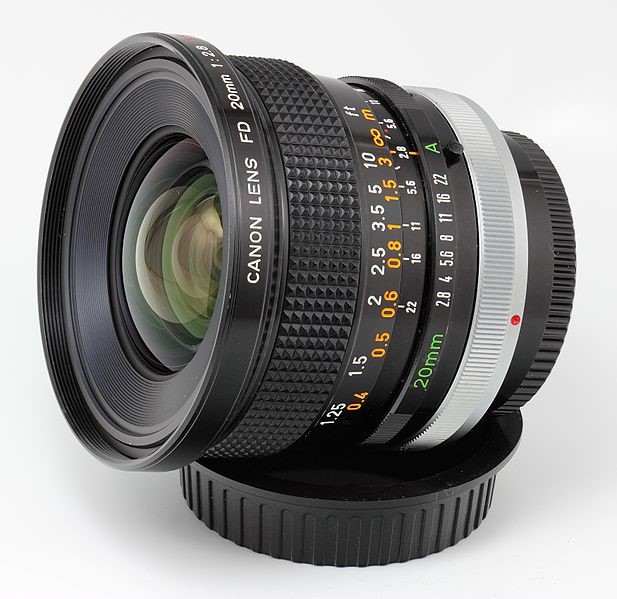
This ultra-wide lens is excellent for capturing landscapes or architectural photography. Despite some noticeable vignetting and coma at f/2.8, the lens performs remarkably well when stopped down. From f/5.6 onwards, the lens delivers good performance across the frame, improving significantly at f/8 and f/11 for corner sharpness. Its medium size, weight, and good price-to-performance ratio make it an ideal choice for budget-conscious landscape photographers. However, note the rotating filter thread, which could complicate the use of polarizing filters. Check prices here.
2. Canon nFD 2.8/24

Slightly tighter than the 20mm, the 24mm offers excellent image quality, particularly when stopped down to f/8 or f/11. At f/2.8, you may notice some vignetting, coma, and soft corners. It’s lightweight, compact, and offers an excellent price-to-performance ratio. This lens is highly recommended for landscape photographers looking for a versatile, affordable, and sharp lens. Check prices here.
3. Canon nFD 1.4/50
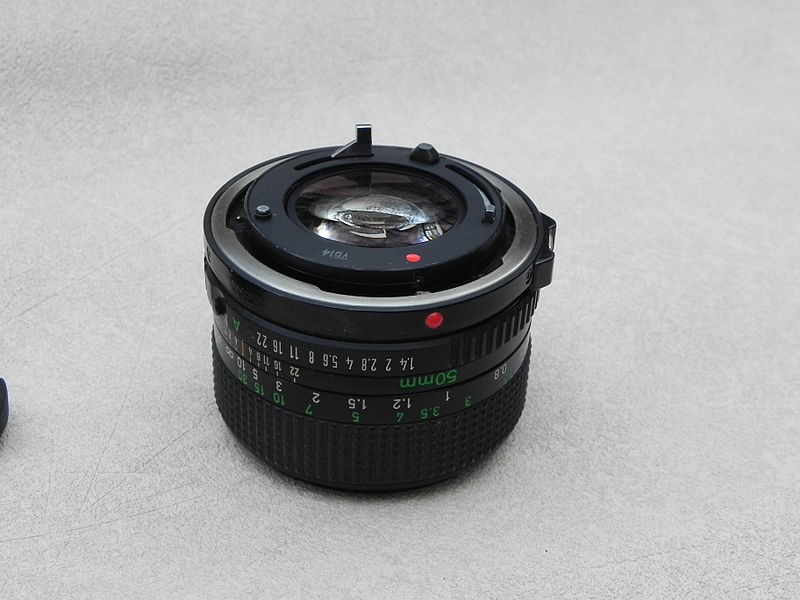
Better than most 50mm lenses at f/1.4, this lens is slightly sharper and significantly lighter and more compact than its FD predecessor. At f/1.4, there is noticeable vignetting, and the bokeh can be a bit busy, but from f/2 onwards, these issues are significantly reduced. By f/5.6, the lens delivers excellent sharpness across the frame, with only a minor improvement at f/8. With a low size, weight, and excellent price-to-performance ratio, this lens is a must-have for any Canon AE1 or AE1 Program owner. Check prices here.
4. Canon FD 1.8/85
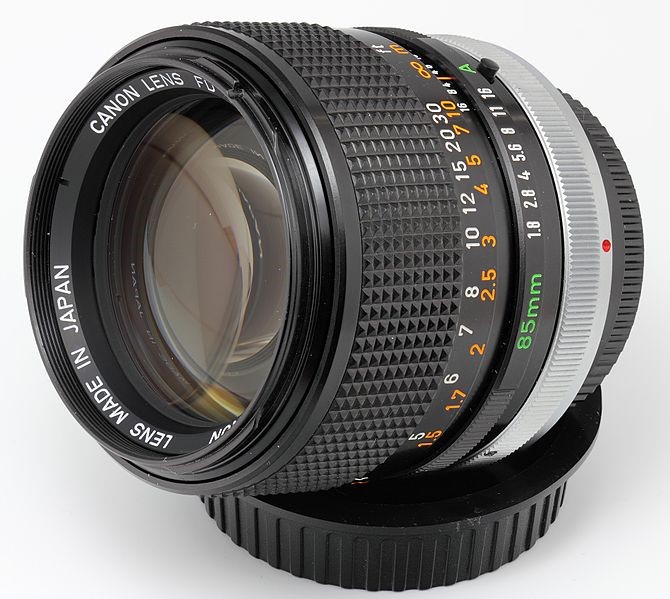
This is an excellent portrait lens that offers sharp images even at f/1.8. The sharpness improves at f/2.8, particularly in the center, but the lens does exhibit some field curvature at shorter distances. The bokeh is pleasant, and axial chromatic aberration is present but minimal. The New FD variant is lighter and more compact than its S.S.C. predecessor, making it a great option for portraiture. However, for landscape photography, you may find the 2/100mm and the 1.2/85 to perform better. Check prices here.
5. Canon nFD 2.8/135

This telephoto lens is another excellent choice for portrait and landscape photography. At f/2.8, it provides sharp images across the frame with pleasing bokeh. Chromatic aberration may be noticeable depending on the subject but stopping down to f/5.6 can help resolve this issue. The lens has a medium size and weight and offers a great price-to-performance ratio.
Embracing the Canon FD Legacy: A Final Thought
The Canon AE1 and AE1 Program, despite their age, still hold a special place in the hearts of many photographers around the globe. And for a good reason! Their robust design, reliable functionality, and compatibility with the wide range of Canon FD lenses make these cameras a powerful tool even in today’s digital era. As you embark on this exciting journey of exploration with your Canon AE1 or AE1 Program, remember that the magic lies not just within the camera but also in the lenses you pair it with. The wide array of Canon FD lenses, with their distinct characteristics and rich history, offer you endless creative opportunities to tell your story in a unique way.
Moreover, with the possibility to adapt FD lenses to modern camera bodies, you can continue to enjoy the remarkable qualities of these lenses even if you decide to transition to a newer system in the future.

